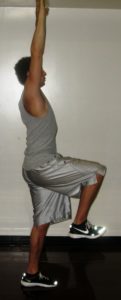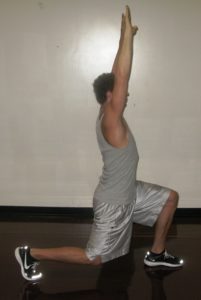by Mitch Hauschildt, MA, ATC, CSCS
I have long used and preached the use of what I call “dense exercises” for rehab, sports performance training, and general fitness, so I think it is something worth looking at. They offer a ton of advantages over more traditional single joint or low threshold movements. They are used extensively in our PROvention™ Training system and also a big part of our latest training system to improve movement quality, Neurofacilitation for Better Movement.
I define dense exercises as any movement that layers complexity on top of known, high quality exercises, including adding load, using multiple planes of motion, and/or adding or subtracting an extremity. A few examples of this are taking a regular squat and making it single leg squat or placing the load overhead or by placing a load overhead while performing a single leg squat.
Another great example of a dense exercise is taking the simple miniband sidestep exercise that is often effective for improving hip control. We can layer on top of it by using a longer band and turning it into a Brugger’s movement or using a sandbag and band to load the posterior chain. You can find examples of other options for making the miniband sidestep more dense by looking at one of my past posts here.
What makes dense exercises so effective?
- First and foremost, they train people to their neural edge. This is important for motor learning to take place, which is ultimately necessary for improving movement abilities which will translate to improved performance and decreased pain.
- Second, it better replicates the movements that both athletes and the general population perform on a regular basis.
- Finally, it maximizes training time. Our athletes, clients and patients are busier than ever, so we need to make sure we can utilize the limited time that we have.
What are some examples?
Aside from the ones I already cited, here are a few more of my favorites (there is a very large list to pick from):
- Turkish Get Up: This is a complex, total body movement that requires both stability and mobility.
- Overhead Reverse Lunge with Single Leg Stance: A great single leg activity that requires thoracic spine mobility, trunk stability, single leg strength and lower body stability.
- Kettlebell Windmill: A beautiful movement that requires a lot of rotational control as well as thoracic mobility and hip control.
Are there any concerns over using dense exercises?
As with any movement, there are things that we need to be careful of and aware of. My biggest concern with promoting their use is that all too often, people attempt to jump into them too quickly. They are fun and sexy looking movements, so everyone wants to jump to them right away. We need to remember that because they are often very complex, they need to be used when they are properly progressed into them. That isn’t to say that all dense exercises have to be very complex. For example, something as simple as adding a band around the knees of someone as they squat, makes it much more dense.
The premise is to layer complexity, even in small ways, on top of a basic movement. Doing so can maximize training opportunities and help everyone move more efficiently and effectively.







Leave a Reply